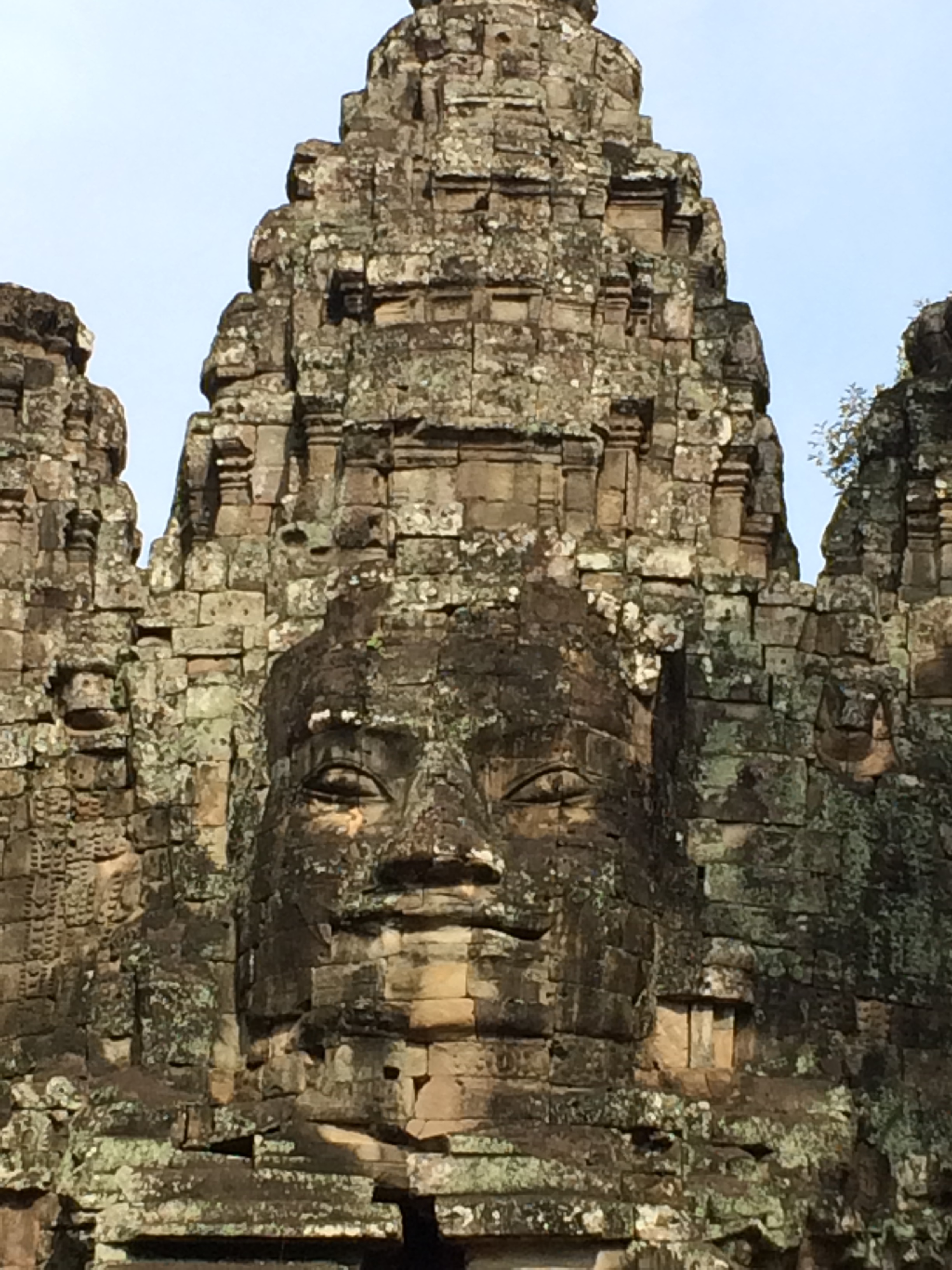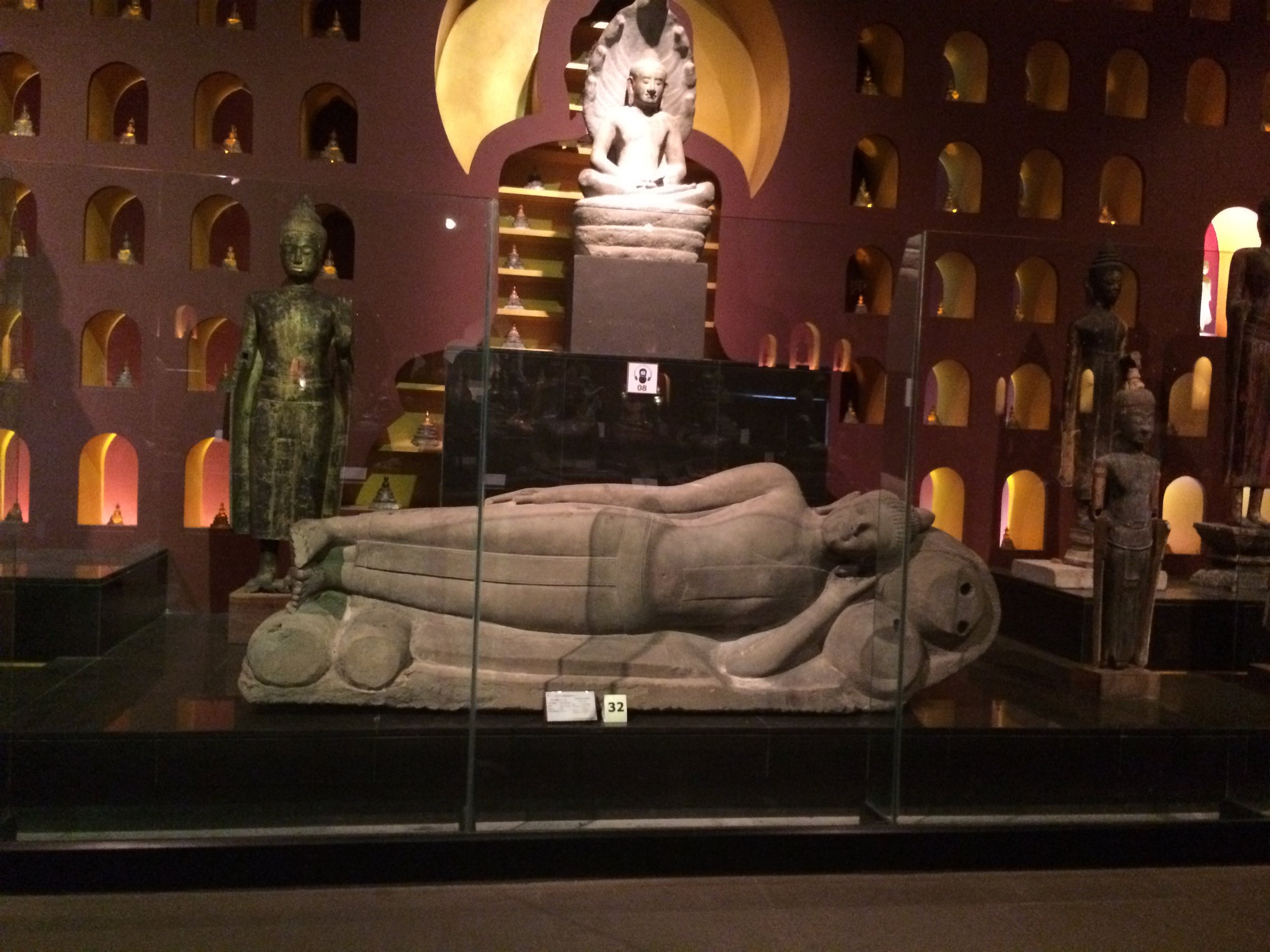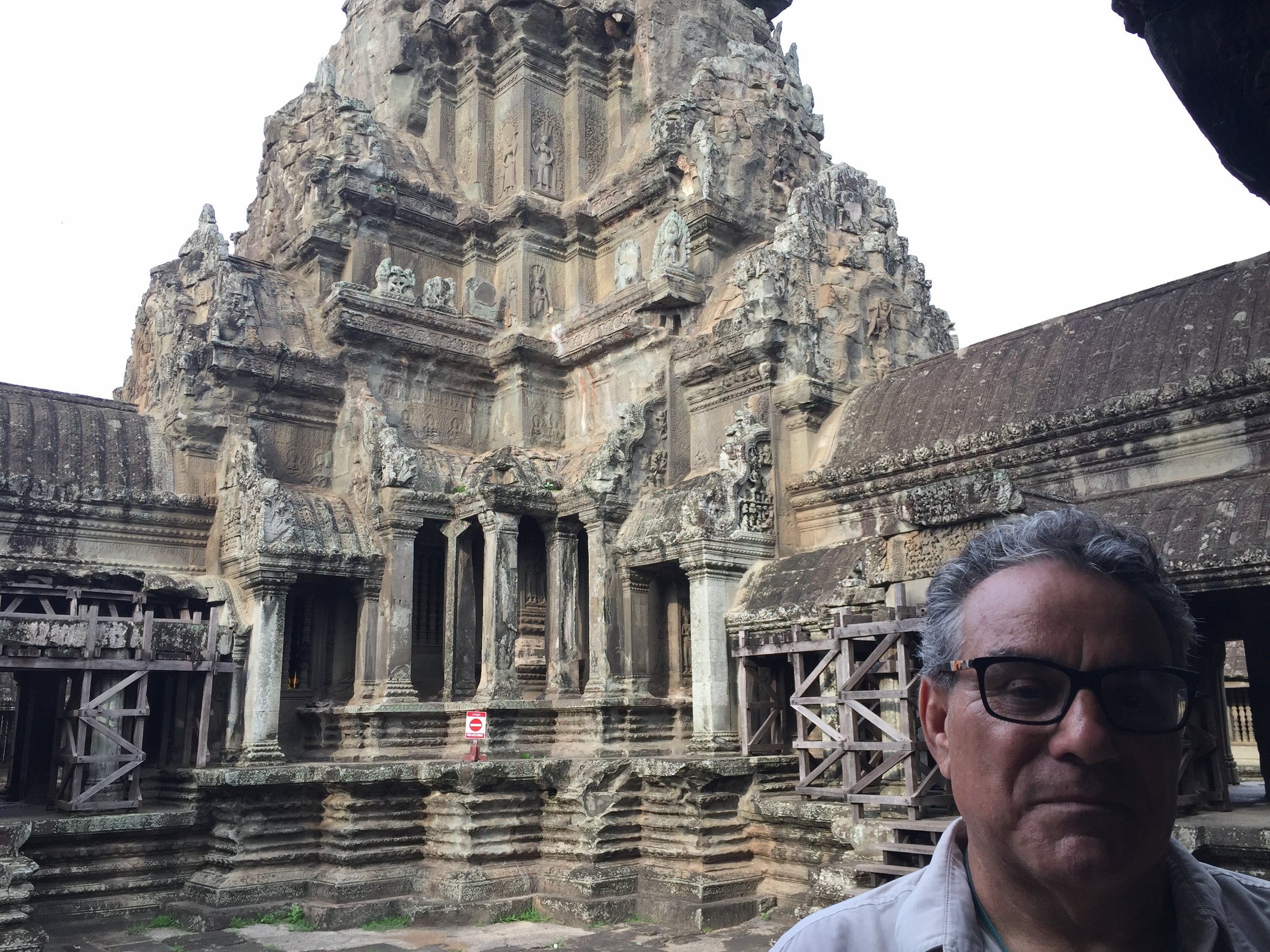Relaxing at the pool with happy hour
Siem Reap
We arrived at Siem Reap by bus. The trip was 6 hours from Phnom Penh. The countryside was flat, lower than the road, clearly sectioned into rice patties, some wet and others not. There was also some small trees, soft wooded trees, reminded me of Florida. As we entered the city it seemed smaller than we imagined, but with wide roadways and set back stores. Later we would take the tuk-tuk to the Hotel Billinal and did pass more narrow active streets. One street had the place maker sign: “Pub Street”; we will have to return there. This boutique hotel is really nice, with a great big pool with covered poolside cabana and nice landscaping. Our host Julia set up our licensed tour guide and the tuk-tuk driver, for the next several days. We had happy hour drinks, massages and dinner at the hotel; We would certainly recommend the Hotel Billinal and really enjoyed doing business with Julie and her staff. Now, early to bed for the first Circuit of Temples.
8th Wonder of the World
Siem Reap is the perfect base of operation from which to visit the temples of Angkor, considered the eight wonder of the world. Here, the Cambodian culture and spiritual devotion fused, making this area one of the most impressive ancient sites on earth. The fusion arises from the merger of the Hindu faith of India influences and the Buddhist faith of China influences. These temples were created by Jayavarman II and Jayavarman VII, (aka Jaya II and Jaya VII), and Suryavarman II (Sury II)
The Large Circuit
You purchase your tickets in town at a large complex
The large circuit of temples is farther away from the hotel and city than the blockbuster Angkor Wat. We opted to follow a route advised by Lonely Planet, start with the small temples. It surprised us as to the distance, but riding in a tuk-tuk in the cooler morning air is actually refreshing; the heat was to come later. We arrived at the central ticket office which is modern and flamboyant in architecture. The 3 day pass is $62 each; Also, we wanted to make sure Janet was recuperating so wanted a more relaxed pace.
The entire area, roadways and entrances, has control points where you must stop and display your ticket to security personnel, our guide tells us that this keeps the areas safe and free from pickpockets. As we drive we pass massive stone walls running many miles.
To reach our ur first stop we enter from a massive gate with soldiers that are pulling the gate, it was a great way to enter into this mysterious world. The first temple was at Preah Khan (Sacred Sword). This is a fusion temple dedicated to Buddha, and the Hindu’s Brahma, Shiva and Vishnu. This is where we first got a small handle on how these religions were accepted and merged in Cambodia, causing the sculptures and carvings to take on the characteristics favored by each faith. Of note here are the immense corridors that act like an unending hall of mirrors.
We would have 5 additional stops throughout the morning, our tuk-tuk driver did a great job on the route and information. The sites varied from small to mid size, all impressive.
It was really hot by the third stop. We where sweating badly in the hard sun. We decided to go back to the hotel to freshen up, just a short stop over, talked to Julia about the projected “Sunrise” excursion for tomorrow, and headed off to the downtown district called the “Alley”. This is the location of Pub Street and our restaurant of choice, “the Red Piano”; also Tomb Raider Angelina Jolie’s favorite we heard. The Cambodian food was tasty and the $1 Angkor draft beers quenched the thirst. Enjoyable was a singing duet, actually performing across the street at another open bar, with a female vocalist who was superb. The tune selection was varied so both of us heard some favorites. We saw then up close at dinner several days later.
Now , we would spend the afternoon at the National Museum of Angkor. This was a new high tech museum dealing creatively with the ancient cultures of the area. No photos were allowed, but our secret cameraman was pretty sneaky. Some of the information imparted is set forth in the preamble. The audio guide was really good describing the religious aspects of the Hindu faith. Surprising to us, was the audio narrator had an indisputable American female voice, no twang but rather a precise delivery; no Brit or Aussie accent.
Traditional meal at the hotel
We returned home for a dip in the wonderful pool and happy hour refreshments. We decided to do some writing and planning, and then again had dinner at the hotel. The young chef had graduated from the local culinary school and turned out another flavorful dinner.
Angkor Wat
Angkor Wat at sunrise
The architecture at this site is the pinnacle of Cambodian glorification of the Hindu faith. The King, Jayman VII, decreed the massive construction of this temple in reverence of the God Vishnu. Later King Sury II decreed expansions of Angkor Wat to revere and merge his Buddhist faith into the temple. Such construction also sought to reinforce the power of the Kings. The site size is 1350 x 1500 meters, once surrounded by a watery moat. It is argued that it's splendor allowed it to survive and to remain intact after the country turned to Buddhism. It remains a pilgrimage site for Buddhist monks.
The sunrise view is slightly tarnished by clouds, but as the bright sun rises slightly it hangs above this superstructure like a brilliant orb. The pinnacle towers and sun reflect in the decorative pools. We joined many folks that sat at the waters edge; some sat further back up upon the Library structures of which there are four in this temple complex. After the sunrise we walked from one end to the other of this massive structure. Our guide took us in the side entrance to avoid the beginning mass of visitors. The entrance lead us into long covered miranda with elaborate carvings running in a horizontal direction that spelled out the great events in King Java VII’s life.
See the great pics below of the site
Climbing to the top. As we meandered into open courtyards we noticed the height of the pinnacle towers is amazing. The grandest is the middle tower which we were able to climb up. The super steep and narrow steps had been fortified with metal rails. The security guides control the number of climbers. Once at the top, you are welcomed into the high temple which now displays a large Buddha figure. This chamber has stone walls that are filled with symmetrical holes that once displayed brilliant gems. The panoramic view of the entire complex from this height and vantage point is amazing. There are so many interesting architectural details in this complex; the shear size of the sandstone blocks, the intricate site plan, the artistic carvings, the reflective pools of water, and the statutes of religious figures and the protectors. Most everything presented here deals with religion, first about “Vishnu” ---the protector, and then about “ Shiva”--- the destroyer, aka the after life. Eventually, the merger of the Buddhist faith with the Hindu faith caused the addition of Buddhist figures into the complex. It will take us a lot more study about the Hindu and Buddhist faiths to make the greatest sense of this wonderful tribute by a King to his religion.
Angkor Thom
Angkor Thom is 4 times bigger then Angkor Wat, at about 10 Sq. KM. It was the last great capital built for the Khmer empire by Jaya VII, protected by formidable walls and surrounding moat, partly in response to earlier invasions of the Cham tribe of southern Vietnam. The entrance gates are flanked by 54 demons and 54 gods engaged in an epic tug of war. This competition deals with the religious act called “Churning the Ocean of Milk”. We will have to get back to you on why that is important.
Right in the middle of Angkor Thom is the temple of “Bayon”, representing the legendary King Jayavarman VII ( Jaya VII), who was considered a great leader and warrior, who also had an inflated ego. Bayon has 54 gothic towers decorated with 216 enormousfaces of the gods that have a resemblance to the King. These are impressive. Maybe more so, is the 1.2 KM “bas-relief”carvings on the outer wall that incorporates 11,000 figures that portray everyday life in 12th century Cambodia and the successes of King Jaya VII.
It was also interesting to see the “ Terrace of the Elephants”, a 350 m long grand stand and wall decorated with parading elephants that abuts the central square. Here is where elephants were trained and also where they were paraded along with horse drawn chariots and infantry. The imagination envisions a spectacular display.
The “Terrace of the Leper King” was memorable because of the height of the retaining walls, some 7 meters, that surround the central pavilion and are decorated with 5 tiers of meticulous carvings, some have avoided the elements and are very fresh looking. The terrace pavilion displays a replica statue of “ Yama” the god of death, and this site is now believed to have been a crematorium.
Tomb Raider Temple, aka “Ta Prohm”
On the third day we started at the tomb raider temple where the movie with Angelina Jolie was filmed. This is a smaller temple site built bye Jaya VII in 1186, but really elegant. The amazing part is that nature has been allowed to reclaim the site and stones throughout these ruins with gigantic trees and vegetation growing up and down over the temple walls. It is really magical.
After a long visit we said good bye to Tomb Raider. We then got on the tuk-tuk and drove 21 KM to the Rolous temple area. The earliest built temple by the Khmer is called “Preah Ko”dedicated to Shiva in AD 877.
This was then the capital of the empire under King Indravarman I. Of note, it has elaborate inscriptions and ancient Angkorian plasterwork that has survived and is beautiful.
However, hands down the most amazing temple nearby is “Banteay Srei”, meaning “Citadel Of Women”, which is cut from pinkish stone and includes the finest, most detailedstone carvings anywhere in Cambodia, some say in the world and some say only women could have done the art work. This temple was begun in AD 967 but not commissioned by a king , but rather by “Brahman”, a rich tutor of lesser known King Jaya V. The art work was beautiful and this visit was a great way to end the tour.
Fire in the City.
That evening we prepared for our move to Battambang, a northern western city. As we stepped out for dinner it became apparent from the smell of ash that a fire had occurred. Apparently, the house across the street from the hotel had been burning and while the owner and fire department negotiated the price for extinguishment, the structure collapsed. Our host Julie was very concerned about smoldering ash and the spread of fire to next door homes and possibly her hotel. Our host also knew the owners of the destroyed property, who were Aussies that had just purchased the property. No one knew if insurance was in place---unlikely. A fellow guest and new friend Jerry from (Cleveland living in Australia) had taken photos of the fire and trucks. He too has been traveling many months. We wish him well.






























